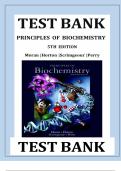TEST BANK w
PRINCIPLES OF BIOCHEMISTRY
w w
5TH EDITION
w
Moran |Horton |Scrimgeour |Perry
w w w
TEST BANK w
,Principles of Biochemistry, 5th Edition Test Bank By: Moran, Horton, Scrimgeour, Perry
w w w w w w w w w w w
Contents:
Chapter 1
w Introduction to Biochemistry w w 1
Chapter 2
w Water 10
Chapter 3
w Amino Acids and the Primary Structures of Proteins
w w w w w w w 27
Chapter 4
w Proteins: Three-Dimensional Structure and Function
w w w w 46
Chapter 5
w Properties of Enzymes w w 65
Chapter 6
w Mechanisms of Enzymes w w 85
Chapter 7
w Coenzymes and Vitamins w w 104
Chapter 8
w Carbohydrates 119
Chapter 9
w Lipids and Membranes
w w 137
Chapter 10
w Introduction to Metabolism w w 153
Chapter 11
w Glycolysis 169
Chapter 12
w Gluconeogenesis, The Pentose Phosphate Pathway, w w w w
and Glycogen Metabolism
w w 185
Chapter 13
w The Citric Acid Cycle
w w w 199
Chapter 14
w Electron Transport and Oxidative Phosphorylation
w w w w 213
Chapter 15
w Photosynthesis 227
Chapter 16
w Lipid Metabolism
w 241
Chapter 17
w Amino Acid Metabolism
w w 256
Chapter 18
w Nucleotide Metabolism w 269
Chapter 19
w Nucleic Acids w 284
Chapter 20
w DNA Replication, Repair, and Recombination
w w w w 300
Chapter 21
w Transcription and RNA Processing w w w 315
Chapter 22
w Protein Synthesis
w 330
Chapter 23
w Recombinant DNA Technology w w 348
,Chapter 1 Introduction to Biochemistry
w w w
1) Which welements waccount w for w more wthan w97% wof wthe wweight wof wmost worganisms?
A) C, w H, wN, wMg, wO, w S
B) C, wH, wN, wO, w P, wS
C) C, w H, wN
D) Fe, wC, wH, wO, w P
E) Ca2+, wK+, wNa+, wMg2+, wCl-
Answer: w B
Page wRef: w Section w 2
2) Proteins win wbiological wmembranes w may wbe
A) porous.
B) attached wto wthe wmembrane w surface.
C) span w the wmembrane.
D) All wof wthe wabove
E) B wand wC wonly
Answer: w D
Page wRef: w Section w 3
3) Which wstatement wabout wcellulose wis wfalse?
A) It w is wthe wmost wabundant w polysaccharide w in wnature.
B) Its wmonomers w are wjoined w by wglycosidic wbonds.
C) It wis wpresent win wthe wstems wof wflowering wplants.
D) The whydroxyl wgroups wof wneighboring wcellulose wmolecules winteract wto wform wstrong,
winsoluble wfibers.
E) It wis wa w branched wpolymer wof wglucose.
Answer: w E
Page wRef: w Section w 3
1
, 4) When wKeq wof wa w reaction w= w1, wthen
A) the wforward wreaction wis wfaster wthan w the wreverse w reaction.
B) the wreverse w reaction wis wfaster w than wthe wforward wreaction.
C) the wforward wand wreverse w reaction wrate wconstants ware wequal.
D) more w products ware w formed wthan w reactants.
E) fewer w products ware w formed wthan w reactants.
Answer: w C
Page wRef: w Section w 4
5) Which wstatement wis wtrue wabout wa w reaction wwith wan wequilibrium wconstant, wKeq, wequal w to w1000?
A) The wforward wrate wconstant w is w1000 wtimes wgreater w than w the wreverse wrate wconstant.
B) The wforward wrate wconstant w is w3 w times wgreater w than wreverse w rate wconstant.
C) The wforward wrate wconstant w is w1000 wtimes wsmaller wthan wthe wreverse w rate wconstant.
D) The wforward wrate wconstant w is w3 w times wsmaller wthan wthe wreverse w rate wconstant.
E) There wis wnot wenough w information w given wto wcompare wthe wforward wand wreverse w rate
wconstants.
Answer: w A
Page wRef: w Section w 4
6) The wstudy w of wthe wenergy w changes w during w metabolic wreactions wis wcalled .
A) bioinformatics
B) metabodynamics
C) thermometrics
D) bioenergetics
E) biological wheat w dynamics
Answer: w D
Page wRef: w Section w 4
7) A wspontaneous wchemical w reaction walways w has w a change.
A) positive w Gibbʹs wfree w energy
B) negative wGibbʹs wfree w energy
C) positive wenthalpy
D) negative wenthalpy
E) positive wentropy
Answer: w B
Page wRef: w Section w 4
2




